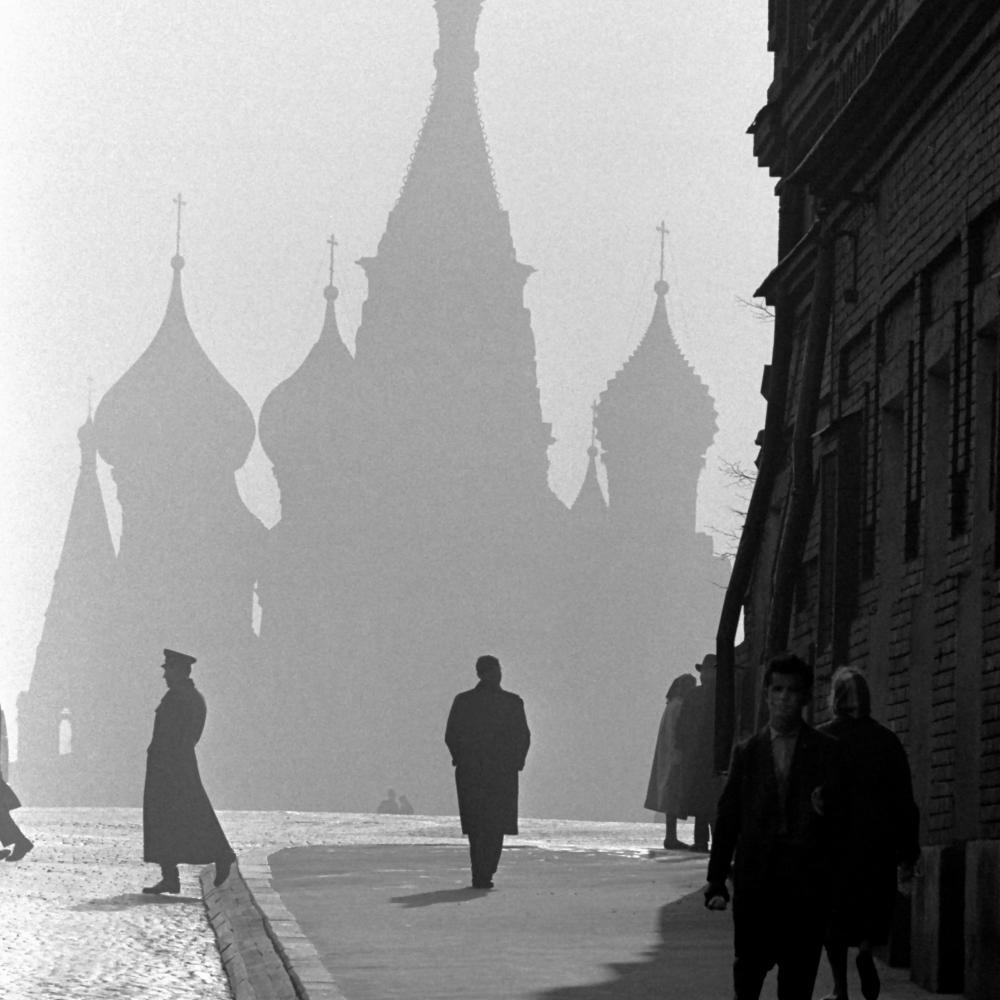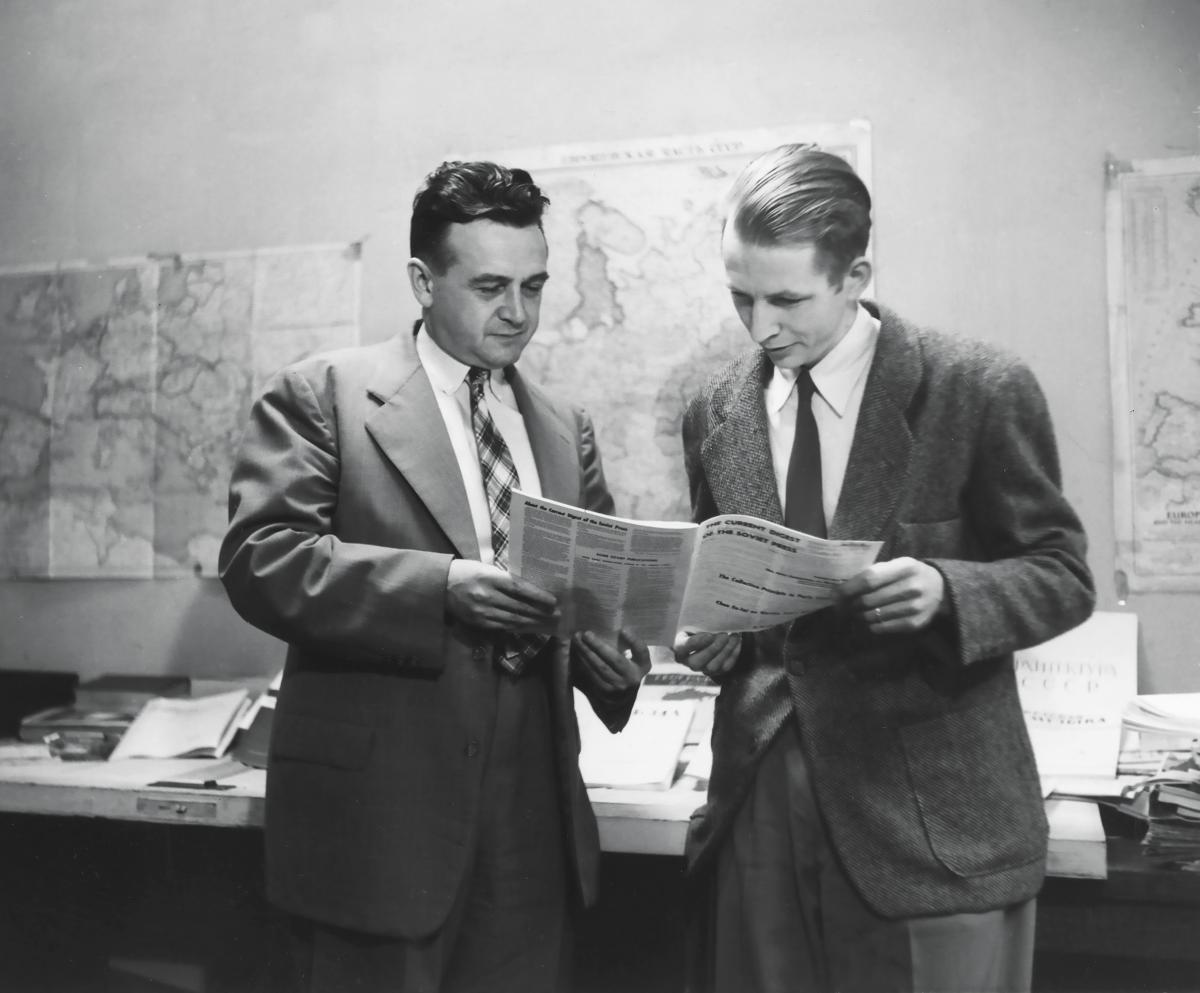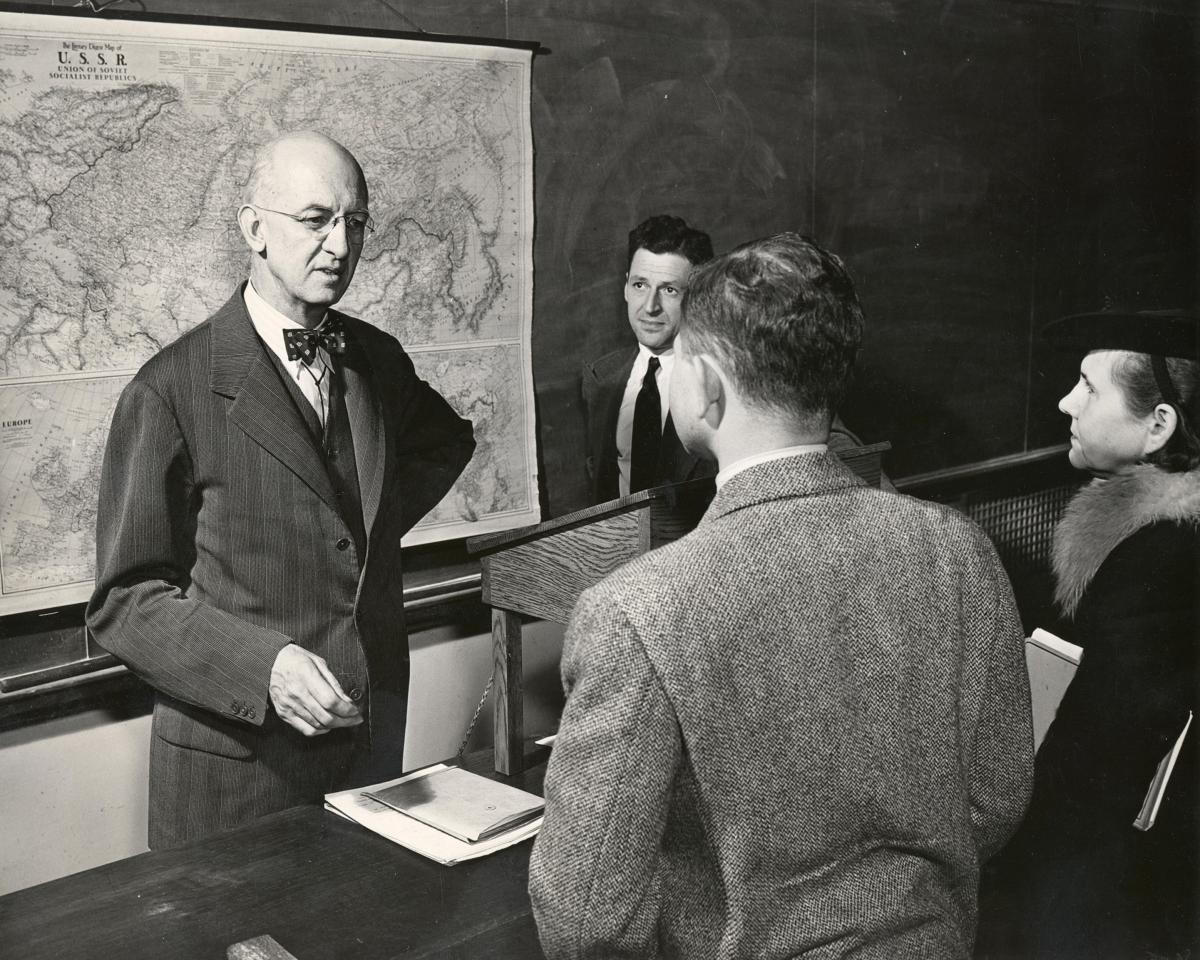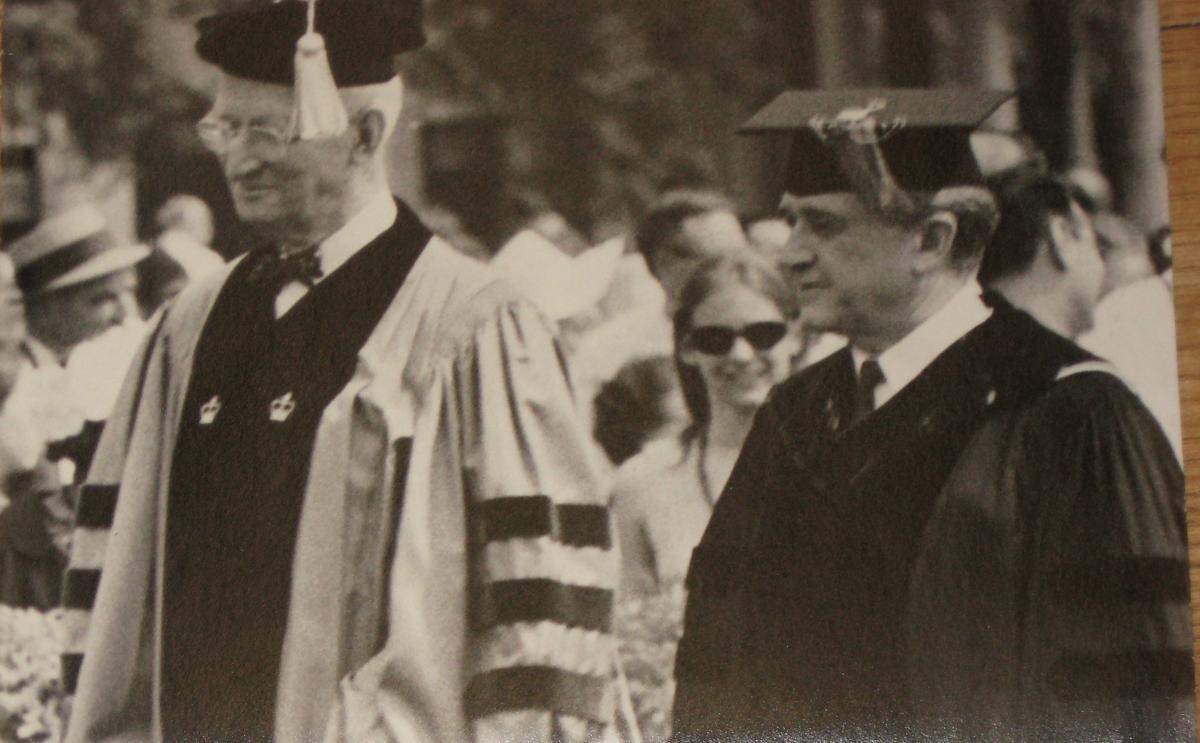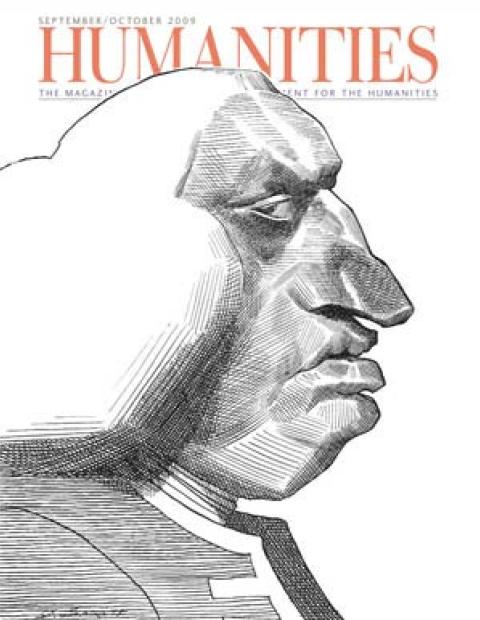When Winston Churchill ominously announced in March 1946 that an “Iron Curtain had descended over Europe,” the United States government employed around two dozen experts on the Soviet Union and even fewer on Central and Eastern Europe. Two years later, after a steady drumbeat of Cold War crises, the young Central Intelligence Agency employed thirty-eight Soviet analysts, only twelve of whom spoke any Russian. The few university-based Russia specialists varied tremendously in intellect and energy; only a handful were willing and able to contribute to shaping policy. How could American officials chart a foreign policy without knowing what was going on inside the Soviet Union, let alone inside the Kremlin? As Geroid Tanquary Robinson, head of the USSR analysis for wartime intelligence and the founding director of Columbia’s Russian Institute, put it, “Never did so many know so little about so much.”
Into this breach stepped a handful of scholars, including Philip Edward Mosely, the man who would become the most influential Sovietologist of the Cold War. He lacked the name recognition and elegant writing style of the diplomat George Kennan, whose 1947 “X” article introduced the concept of containment to the world. Nor could he rival the publication record and scholarly reputation of Harvard professor Merle Fainsod, whose 1953 book How Russia Is Ruled introduced generations of readers to Soviet politics. And Mosely was nowhere near as colorful a character as the economic historian Alexander Gerschenkron, whose 1952 essay on “economic backwardness” remains a subject of debate into the twenty-first century. Mosely’s contributions to the development of Soviet Studies have received little attention. But in a field of study that emphasized its practical application to policymaking, no one else was so adept at working the lines of influence and power that connected America’s campuses and its capital.
Mosely did more than anyone to underwrite the achievements of Soviet Studies in the 1950s as well as its explosive growth in the 1960s. Thanks to the institutions he created and led, Soviet Studies went from scholarly backwater to intellectual juggernaut in a matter of years. Scholars in the field published dozens of books that peeked inside the Soviet enigma; they also trained hundreds of other experts to do the same. Sitting at the intersection of scholarship, intelligence, and philanthropy, Mosely created a field in which practitioners like himself could imagine, as Secretary of State William P. Rogers noted, “no line between government and academic work.” In the process, though, Mosely set the field up for the controversies that wracked it in the years before his death in 1972. In other words, he put Sovietology on a collision course with that phenomenon generally known as the sixties.
Mosely was raised in the town of Westfield, Massachusetts, in the 1910s. For a determined Cold Warrior, he had surprisingly liberal views in his youth. Much later, he would regale a former student about his trip to celebrate the release of socialist Eugene Victor Debs from prison in 1921. Perhaps it was politics that got young Mosely interested in Russia, or perhaps it was his chance encounter with a Russian immigrant on a trip to the library in Springfield. In any case, Mosely studied Russian with a tutor until leaving for Harvard at the age of sixteen. After completing his bachelor’s degree, he began graduate study in history, writing a dissertation on Russian diplomacy in the 1830s. Perhaps most crucial for his future career was a two-year stint in Moscow for dissertation research.
Mosely’s Moscow years, 1930 to 1932, coincided with the immense and rapid changes of the first Five-Year Plan, Stalin’s program of forced-draft industrialization in the name of building socialism. Moscow teemed with people from the countryside, basic goods were in short supply, and small private enterprise was eradicated in favor of rationing. Mosely worked in government archives, meanwhile scavenging food and supplies through networks of friends, a process no doubt aided by his marriage to a Russian woman. His Soviet sojourn left a deep impression on Mosely, visible in letters home; they movingly describe the difficulties of everyday life as well as enthusiasm for the promises of a brighter future. Mosely repeated the praise for the USSR typical of sympathetic American journalists like Louis Fischer, whom he knew well. Even as the show trials and purges accelerated, for instance, Mosely called the USSR a “defender of peace” and praised its “social welfare” programs.
This assessment of the USSR was no doubt shared by other American members of the Institute for Pacific Relations, an organization that brought together scholars, missionaries, and business people interested in Asia. The organization grew increasingly interested in the USSR in the 1930s, an interest justified by the Soviet Union’s Pacific coastline. The real interest, though, was political, as the institute’s American members included a handful of Communists and many others sympathetic to the Soviet cause.
After a prolonged itinerancy, which included a Social Science Research Council (SSRC) fellowship in the Balkans, Mosely landed at Cornell University in 1936. He immediately demonstrated entrepreneurial zeal, winning a Rockefeller Foundation grant to expand Russian studies and serving as secretary of the Committee on Slavic Studies of the American Council of Learned Societies (ACLS). Over the next decade, Mosely would help steer Rockefeller, SSRC, and ACLS work toward the new enterprise of area studies. The transformation of American academic life during World War II would turn Mosely (and many other ambitious and talented scholars) from a grant recipient into a grant-maker, and from a diplomatic historian into a diplomat.
The arrival of World War II offered remarkable opportunities. Even before Pearl Harbor, Mosely joined a program of the Council on Foreign Relations to conduct confidential studies on strategic issues. After the German invasion of the USSR in June 1941, he organized Cornell’s intensive program in Russian, arguing that it would “enable the Government to meet its rapidly expanding need for men able to use Russian.” The program introduced a number of future Sovietologists, including political scientist Robert Tucker and sociologist Alex Inkeles, to the Russian language. Mosely also helped the Institute for Pacific Relations add some two dozen other languages, in the process providing the basis for Army and Navy programs designed to prepare soldiers for occupation of foreign countries. These military programs would train dozens of future experts, including historians Martin Malia and Richard Pipes as well as numerous social scientists.
After three years of commuting from Ithaca to New York and Washington, Mosely abandoned his university post for full-time government work. He served in a dizzying succession of State Department posts related to wartime diplomacy and, increasingly, planning for the peace. As postwar topics became the subject of diplomatic negotiations, Mosely accompanied the secretary of state to conferences in Paris, Moscow, and Potsdam, calling for Allied cooperation in war and peace. As American policy makers debated the shape of postwar Europe, Mosely found himself more open to cooperation with the USSR than many of his colleagues. Looking back at these discussions, Mosely ruefully noted that the policies he promoted provided the only “real chance” for postwar Western-Soviet cooperation, but that other policies had prevailed.
Mosely’s entry into high diplomacy hardly slowed his academic work. He participated in two Rockefeller Foundation conferences that outlined the work of area studies, connecting scholarship, training, and national needs. Rather than bring scholars together by discipline, it would unite those interested in a particular world region. A hallmark of the area programs was their direct relevance to government officials fighting the war and planning the peace.
Area studies was a product of a network of philanthropists, scholars, and diplomats who planned the enterprise during World War II and built it in the decade or so afterwards. Mosely knew everyone in that network, and was active in all three spheres simultaneously: working at the State Department, editing the British journal-in-exile Slavonic and East European Review, and consulting for the Rockefeller Foundation. He promised to join the Rockefeller Foundation at war’s end, but instead took a job at one of its major postwar ventures, the Russian Institute at Columbia University.
At Geroid Robinson’s invitation, Mosely came to Columbia to teach Soviet international relations and held an appointment in the political science department. But his work, despite his departmental affiliation, did not stay within either his adopted discipline or his original one, history. Like others of his generation whose ties to scholarship were weaker than their ties to diplomacy, he published articles frequently in Foreign Affairs, but rarely in Political Science Quarterly. His articles evinced little sympathy for the USSR but were hardly calls to arms. In 1948, he called on the United States to restrain its conflicts with the Soviet Union, and hoped instead for “peace by mutual toleration.” Though the Sovietization of Eastern Europe and the expansion of Soviet influence in Asia led Mosely to abandon those hopes in the 1950s, he still insisted that there were important opportunities for postwar amity that fell victim to Western disorganization.
Even before succeeding Robinson as director of the Russian Institute in 1951, Mosely wielded his influence over Soviet Studies by building a Russian (or is that Russianist?) empire at Columbia. Insisting that Soviet Studies could best serve the national interest if it was centrally coordinated, Mosely helped establish the Joint Committee on Slavic Studies (JCSS), a combined effort of the ACLS and SSRC. Serving as its founding chair, Mosely presided over what amounted to the Sovietology’s Politburo. The committee’s work consisted of heavy lifting rather than high politics. At a time when no American scholars could visit the USSR—the only one there in the 1940s was Robert Tucker, who spent seven years waiting for Soviet authorities to grant an exit visa to his wife Evgeniia—the primary job of the committee was to develop sources. In 1953, for instance, the year of Stalin’s death, its big concern was Soviet periodicals. The committee had to sort out which American libraries should hold which of the dozens of journals and newspapers, like Izvestiia and Pravda, and how to keep them safe from overeager American postal inspectors. The Joint Committee spent 1956—the year that Nikita Khrushchev denounced Stalin in his headline-making Secret Speech—organizing a microfilm version of Library of Congress holdings and sending a young historian (Martin Malia) to arrange book-buying deals with Soviet publishers. They spent plenty of time and tens (probably hundreds) of thousands of dollars organizing the Current Digest of the Soviet Press, a translation service that never broke even and survived on secret but well-known CIA subsidies. The infrastructure built by the Joint Committee made possible scholarship on an otherwise inaccessible country.
In addition to leading and hosting the Joint Committee and its Current Digest, Mosely branched into new territory. After witnessing the failure of Kennan’s effort (together with the CIA) to resettle Russian émigré scholars in a Washington-based Eurasian Institute, he built a successor organization housed at Columbia. The Research Program on the USSR received Ford Foundation monies channeled through the East European Fund (on whose board, coincidentally, Mosely served), and paid émigré scholars and former government officials to write monographs in English or Russian about their experiences. Administered by Alexander Dallin (coincidentally, Mosely’s student, and later one of the most prominent students of Soviet politics), the program sought to produce primary sources about Soviet life while also offering financial support to émigrés. These apparent coincidences, of course, demonstrate perfectly Mosely’s style as an organizer.
Mosely’s interest in émigrés long predated the CIA’s proposed Eurasian Institute. His professor at Harvard, Michael Karpovich, was the hub of the American branch of émigré Russians. Through Karpovich, Mosely met Boris Bakhmeteff, a wealthy engineer who was the last Russian ambassador in Washington before the Bolshevik takeover. Together, the three men gathered the papers of Russian émigrés and deposited them at Columbia’s library, creating the core of what would later become the Bakhmeteff Archive, a remarkable collection of materials about the cultural, intellectual, and political life of Russia before 1917 and that of its exiles afterward. Again, Mosely used his connections to help expand the base of sources available to scholars of Russia and the USSR.
These activities, though not well-remembered today, are easily documented. Harder to trace are Mosely’s continuing connections to government agencies in the early Cold War—both to promote Soviet Studies and to advise on policy. Nevertheless, a record of declassified documents scattered across government archives shows just how hard Mosely worked to make Soviet Studies useful to government and vice versa. His interest in obtaining sources, for instance, led Mosely to a treasure trove of Soviet party documents that the Germans had taken from Smolensk in 1941, and the American Army had taken from Berlin in 1945. The Smolensk records, along with a much larger set of official Nazi records, passed through the American national-security apparatus. Indeed, the materials were used, in a rare example of interservice cooperation, by Army and Air Force intelligence, the CIA, and the RAND Corporation. By 1954, a White House committee was ready to dispose of the materials when Mosely stepped in to ensure their continued use; indeed, work on the documents was known internally as the “Special (Mosely) Project.” It was Mosely who suggested that Fainsod be the first to work with the materials, and who called for the Smolensk records to be made available at the National Archives.
While Mosely put government in the service of scholarship, as with the Smolensk materials, he more often served government. He spent a good portion of the winter break in 1952 on an official American delegation to Yugoslavia. He also served on the secret White House exercise, Operation Solarium, that shaped Eisenhower’s defense strategy; the so-called New Look favored nuclear deterrence over larger (and more expensive) conventional forces. Mosely was not, of course, solely responsible for New Look, but his involvement in this White House exercise, joined by diplomats (including Kennan) and admirals, indicates the circles in which he traveled.
The best evidence of Mosely’s classified connections comes from a security investigation in 1954, shortly after Mosely had moved from Columbia to the Council on Foreign Relations, where he became director of studies. The episode offers a snapshot of what would later be called the foreign-policy establishment in the early Cold War. Mosely learned in January that his security clearances had been revoked, primarily because of his prior membership in the Institute for Pacific Relations, a target of Senator Joseph McCarthy and others. At the time, Mosely held top secret clearances at nine government agencies, including the White House’s National Security Council (for Solarium), CIA, State Department, Office of Naval Research (which funded his work with an old friend, the anthropologist Margaret Mead), and elsewhere. In response to the denial of clearance, Mosely and his lawyers gathered a docket of fifty-some affidavits from family members, a dozen ambassadors, and a similar number of intelligence officers. The affiants revealed their strong support for Mosely as well as something of their own worldviews. Kennan, the father of containment, wrote that the inquisition into Mosely “plays directly into communist hands,” while blueblood editor Hamilton Fish Armstrong, who identified himself as a seventh-generation American, vouched for Mosely’s “old New England stock.” Whether it was based on Mosely’s politics, his value to the government, or his lineage, the affidavits worked: His clearances were reinstated after six months.
The clearance episode reveals a great deal about Mosely: the extent of his government work, the reach and prominence of his contacts, and, of course, the dangers of past associations even for Cold War insiders. Yet his enthusiasm for government-academic relations remained unshaken, as he maintained his consulting relationships for decades afterward and made his move to the Council on Foreign Relations. It is hardly a surprise that so many of his Columbia students—most prominently, Dallin and Marshall Shulman—were frequent consultants on government projects.
The Council job played to one of Mosley’s great strengths: bringing scholars and government officials together in formal and informal settings. Mosely was a key figure behind an effort to expand these informal conversations to include Soviet as well as American experts and diplomats; the so-called Dartmouth Conferences of the 1960s continued a form of the engagement that Mosely had been promoting since the 1940s. Bringing together mid-level government officials and scientists in an informal setting, as the conferences did, helped pave the way for superpower arms-control agreements in the 1960s.
In other ways, too, Mosely and his generation of Sovietologists helped keep the Cold War cold. Research projects supported by Mosely’s friends in the national security apparatus undermined public (and political) assumptions that the Communist party was an all-powerful force ruling over an atomized population that was waiting for an outside power to unshackle it. Operation Solarium rolled back U.S. efforts to challenge directly Soviet power in Eastern Europe. The Smolensk project underscored the limits of the Kremlin’s reach even within the USSR. And a major Air Force project at Harvard University (one of the few that Mosely didn’t advise) concluded that the Soviet system was relatively stable, and that potential American invaders would not be greeted as liberators. Especially in the early 1950s, when American rhetoric was at its most confrontational, professional Sovietologists like Mosely were a moderating force.
This model of Soviet Studies worked for Mosely and for his generation. Thanks to their efforts to obtain both sources and funding, scholars of what Churchill called “riddle, wrapped in a mystery, inside an enigma” produced remarkable works on the history, culture, and politics of America’s Cold War adversary. The major supporters were all familiar to Mosely: the Rockefeller Foundation, which supported Columbia and other graduate programs in Soviet Studies; the newly ambitious Ford Foundation (with Mosely as an adviser), which established academic exchanges with the USSR; the Joint Committee on Slavic Studies (which Mosely chaired), which promoted the field through grants; and the Office of Education (which Mosely advised), which funded area studies programs after the passage of the National Defense Education Act in 1958.
Mosely’s vision of Soviet Studies, closely tied to national-security interests, loosely connected to academic disciplines, and centrally administered by a self-selected network of scholars (heavily weighted with Columbia and Harvard men), did not survive his lifetime. The field’s rapid growth soon met with a democratizing impulse, as a new national membership organization, the American Association for the Advancement of Slavic Studies, took over some Joint Committee tasks. (The organization, still in existence, will change its name in 2010.) Scholarly exchange, which Mosely first proposed to the Soviet foreign ministry in 1943, came under attack in the 1960s. The exchange program met with increasing controversy in the American academy in what amounted to a generational divide. Students and young faculty chafed at the ways in which the American exchange organizers closely supervised their personal lives, and resented the involvement of the State Department.
For reasons both political and professional, a new generation of scholars rejected the field’s direct involvement in foreign policy. Increasingly critical of American policy in Vietnam and elsewhere, many young scholars rebelled against what they saw as government incursions into academic life. Others preferred to contribute to disciplinary journals rather than policy debates; in doing so, ironically, they benefited handily from the scholarly exchanges that Mosely promoted as well as sources like the Smolensk documents and the Bakhmeteff Archive that Mosely helped organize.
For all of his insights about the USSR and his renewed work in teaching (he had returned to Columbia in 1963), Mosely did not fathom these changes. In an essay published in 1967, as conflicts brewed on campuses all over the country, Mosely praised scholars for their impact on affairs of state. Five years later, upon Mosely’s death, came Secretary Rogers’s praise that Mosely did not distinguish between academic and government work. Undoubtedly an exaggeration, it nevertheless reflected Mosely’s long-standing commitment, forged during World War II, to serve Mars and Minerva, the gods of war and wisdom. Yet by 1972 such sentiments were hotly controversial.
Mosely’s accomplishments were many. He brought together disparate groups to forge a field that shaped foreign policy and academic life for almost three decades. He helped hundreds of students, giving many of them more attention than they received from their ostensible advisers. He aided Russian émigré scholars more than any other non-émigré. Yet the rise and fall of his vision of Soviet Studies tells us as much about the assumptions of the greatest generation as it does about the anger of its successors.

